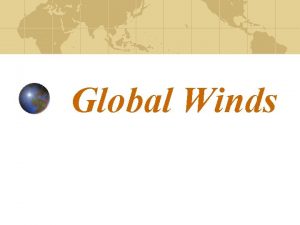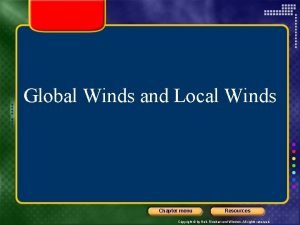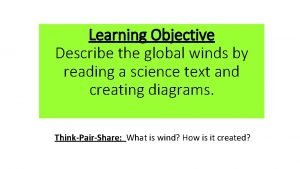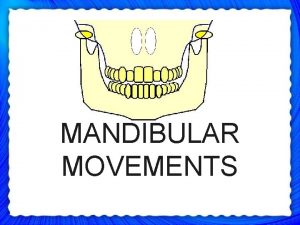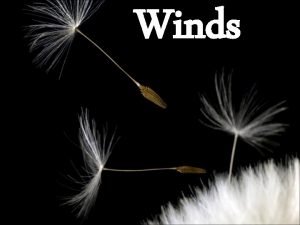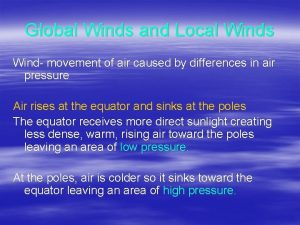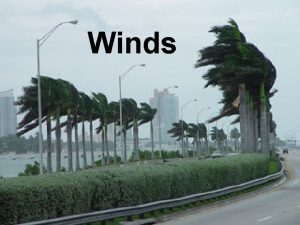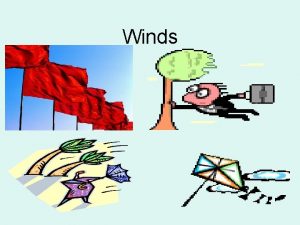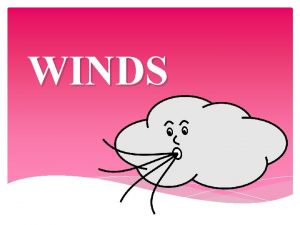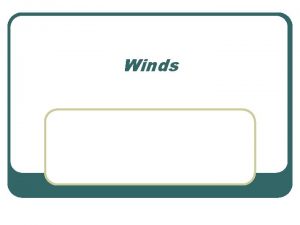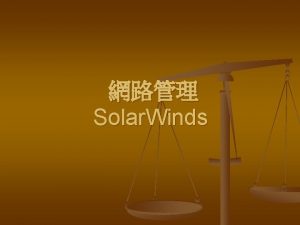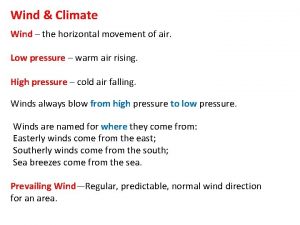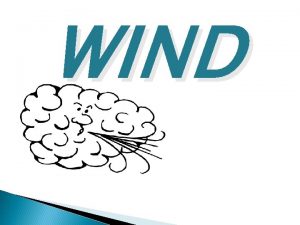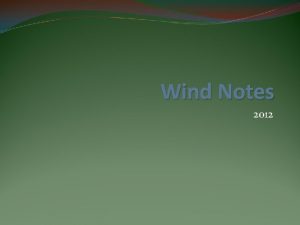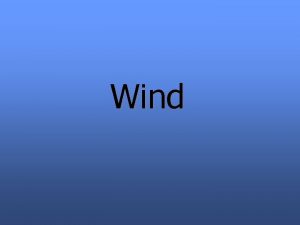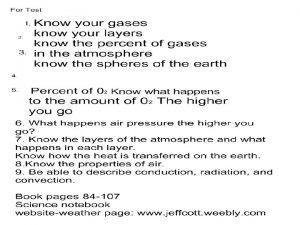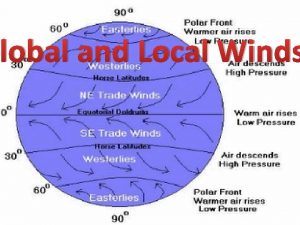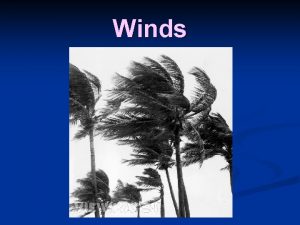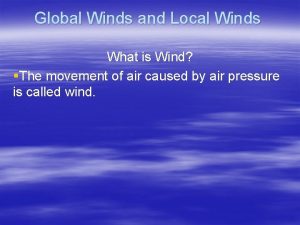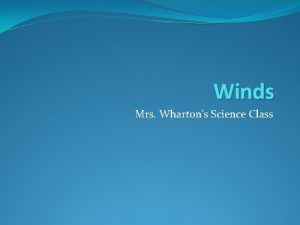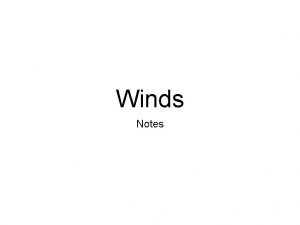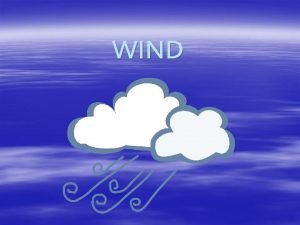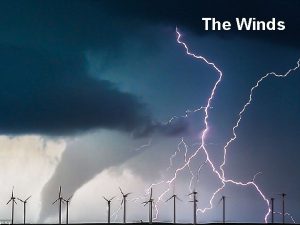Winds What is Wind The horizontal movement of
















































- Slides: 48

Winds

What is Wind? The horizontal movement of air from High pressure to Low pressure. • H L Air moving up or down (vertical) is called a current

L= Low

Pressure is caused by the characteristics of the air Warmer Air X X X Molecules move faster and are farther apart. Less Dense Cooler Air More Dense X X X X X X X X Molecules are close together and move slowly.

Warm Air Rises Cool Air Sinks Warm Air Rising Cool Air Sinking

Convection Currents Cool Air Sinking Warm Air Rising

High Pressure Ok, High Pressure is 1. Dense (heavy) 2. Cool 3. Creates Clear Skies AHHHH! High Pressure

Low Pressure Ok, Low Pressure is 1. Less Dense (heavy) 2. Warmer 3. Brings Lousy Weather L Whew! Low Pressure

High Pressure Low Pressure = = Happy Weather Lousy Weather HL



Winds Blow from HIGH to LOW

low pressure warm or cold air rising or sinking clouds or no clouds clockwise or counterclockwise wind direction winds toward or away from the center high pressure


In a high pressure area, air will (rise, sink) because the air is (less, more) dense. This is because the air is (cold, warm) and (rises, sinks). Therefore, clouds CANNOT form.

In a low pressure area, air will (rise, sink) because the air is (less, more) dense. This is because the air is (cold, warm) and (rises, sinks). Therefore, clouds are LIKELY to form.





There Are Two Kinds of Winds: Global and Local • Global Winds are Winds that blow over long distances around the Earth. • Local Winds are winds that blow a short distance.

Global Winds

Why Do Different Parts of the Earth Have Different Temperatures? North Pole Equator South Pole Thus, radiation is more intense near the equator compared to the poles. For this reason, it’s warmer near the equator than at the poles.

Global Thermal Temperatures

Air Rises at the Equator • Air at the Equator is warm. • Warm air rises. • The Equator is a Low Pressure area.

What Happens to Rising Air at the Equator? • At the Equator, air rises; • As the air moves upward, it cools, • The air begins to turn to move downward. • Cold air sinks at the 30 o zone.

Winds blow from High Pressure to Low Pressure

Let’s Label High Pressure 90°N Low Pressure 60 °N High Pressure 30°N Low Pressure 0° High Pressure 30°S Low Pressure 60°S High Pressure 90°S


Names of Winds • IMPORTANT: Winds are named from the direction they come. • North winds comes from the north; south winds come from the south. • Southeast winds come from the southeast and blow northwest; • Northeast winds come from the northeast and blow to the southwest.

Let’s Label Easterlies Polar Easterlies Trade Winds Polar Easterlies

Trade Winds • The TRADE WINDS are the winds blowing towards the equator. • These winds are Easterlies, blowing from the east. – South of the equator, the winds blow from the southeast – North of the equator, the winds blow from the northeast. • They were named because traders from Europe sailed in these zones on their way to the new world.

Let’s Label Westerlies Prevailing Westerlies

North is Located in the Westerly Wind Belt

Why Don’t The Winds Blow in Straight Lines? • Cold air from both the South Pole and North Pole blows towards the 60 o zone • But the air doesn’t flow in a straight line

Coriolis Effect • Since the earth rotates, winds do not blow directly from north to south or south to north. • Winds curve • They curve because the earth rotates or spins on its axis. • The Coriolis Effect is the curving of winds due to the earth’s rotation.

The ball is going straight, but it looks like it is curving.

Global Wind Animation http: //www. geo. hunter. cuny. edu/ ~tbw/wc. notes/7. circ. atm/animati ons/Global. Wind. html

Zones of NO WIND Doldrums At the equator, which is 0 o latitude, there is a windless zone called the Doldrums. Horse Latitudes At 30 o N and 30 o S, there is a windless zone called the Horse Latitudes.

Horse Latitudes And The Doldrums

Doldrums • Since the Trade Winds blow from both the North and South, a calm zone occurs. • This zone is called the “DOLDRUMS. ” • In this zone, there are no winds. Ships often got stalled for long periods because they needed wind to blow their sails.

Horse Latitudes The Horse Latitudes are zones of calm winds at the 30 o Latitude Lines. The term horse latitudes originates from the days when Spanish sailing vessels transported horses to the West Indies. Since there was no wind, the sail ships that entered this zone, would get stuck for weeks. Since water and food shortages occurred, the crews found it necessary to throw their horses overboard.

o 30 North and South Latitude This is an area of high pressure. Sinking air means no clouds or rain. Air from the Equator and from the 60 o Latitudes cool and Along this latitude, (between descend at the 30 o Latitude. 15 o to 35 o) many of the major deserts are found

Local Winds • Winds that blow short distances and in any direction (depending on pressure) • Remember, winds always blow from areas of high pressure to low pressure.

Sea Breeze any wind that blows from a large body of water toward or onto a landmass Land Breeze is the reverse effect: dry land also cools more quickly than water and, after sunset a sea breeze dissipates and the wind instead flows from the land towards the sea



 Easterlies and westerlies
Easterlies and westerlies Global winds and local winds
Global winds and local winds Local and global winds
Local and global winds Local winds are caused by
Local winds are caused by Earth's rotation makes global winds curve this is called
Earth's rotation makes global winds curve this is called West north west wind direction
West north west wind direction Wind von backbord weicht wind von steuerbord
Wind von backbord weicht wind von steuerbord What is a non movement area
What is a non movement area Axial movements examples
Axial movements examples Mandible movement
Mandible movement Horse latitudes doldrums
Horse latitudes doldrums Bài hát chúa yêu trần thế alleluia
Bài hát chúa yêu trần thế alleluia Khi nào hổ mẹ dạy hổ con săn mồi
Khi nào hổ mẹ dạy hổ con săn mồi đại từ thay thế
đại từ thay thế Quá trình desamine hóa có thể tạo ra
Quá trình desamine hóa có thể tạo ra Vẽ hình chiếu vuông góc của vật thể sau
Vẽ hình chiếu vuông góc của vật thể sau Cong thức tính động năng
Cong thức tính động năng Thế nào là mạng điện lắp đặt kiểu nổi
Thế nào là mạng điện lắp đặt kiểu nổi Dot
Dot Lời thề hippocrates
Lời thề hippocrates Vẽ hình chiếu đứng bằng cạnh của vật thể
Vẽ hình chiếu đứng bằng cạnh của vật thể Bổ thể
Bổ thể độ dài liên kết
độ dài liên kết Môn thể thao bắt đầu bằng từ chạy
Môn thể thao bắt đầu bằng từ chạy Sự nuôi và dạy con của hổ
Sự nuôi và dạy con của hổ điện thế nghỉ
điện thế nghỉ Một số thể thơ truyền thống
Một số thể thơ truyền thống Nguyên nhân của sự mỏi cơ sinh 8
Nguyên nhân của sự mỏi cơ sinh 8 Trời xanh đây là của chúng ta thể thơ
Trời xanh đây là của chúng ta thể thơ Chó sói
Chó sói Bảng số nguyên tố lớn hơn 1000
Bảng số nguyên tố lớn hơn 1000 Thiếu nhi thế giới liên hoan
Thiếu nhi thế giới liên hoan Tỉ lệ cơ thể trẻ em
Tỉ lệ cơ thể trẻ em Tia chieu sa te
Tia chieu sa te Các châu lục và đại dương trên thế giới
Các châu lục và đại dương trên thế giới Thế nào là hệ số cao nhất
Thế nào là hệ số cao nhất Sơ đồ cơ thể người
Sơ đồ cơ thể người Tư thế ngồi viết
Tư thế ngồi viết Hát kết hợp bộ gõ cơ thể
Hát kết hợp bộ gõ cơ thể đặc điểm cơ thể của người tối cổ
đặc điểm cơ thể của người tối cổ Cách giải mật thư tọa độ
Cách giải mật thư tọa độ Chụp phim tư thế worms-breton
Chụp phim tư thế worms-breton Tư thế ngồi viết
Tư thế ngồi viết ưu thế lai là gì
ưu thế lai là gì Thẻ vin
Thẻ vin Cái miệng xinh xinh thế chỉ nói điều hay thôi
Cái miệng xinh xinh thế chỉ nói điều hay thôi Thơ thất ngôn tứ tuyệt đường luật
Thơ thất ngôn tứ tuyệt đường luật Các châu lục và đại dương trên thế giới
Các châu lục và đại dương trên thế giới Từ ngữ thể hiện lòng nhân hậu
Từ ngữ thể hiện lòng nhân hậu

